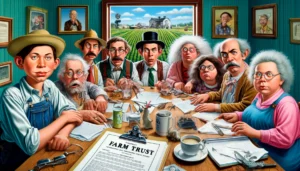
Soil Classification 2.jpg

Soil Classification
Soil classification is the systematic categorization of soils based on their properties, characteristics, and genesis, providing a framework for understanding soil diversity, variability, and management in agricultural and environmental contexts.
Definition:
Soil classification is the process of organizing soils into hierarchical categories or taxonomic units, utilizing criteria such as soil texture, structure, color, parent material, and diagnostic horizons to differentiate and classify soil types.
Fall off the barn roof and busted your keister? Life on the farm or ranch can be tough on the bum. Need a break? Laugh it off at FarmerCowboy.com, the #1 farm humor site. With 20,000 daily visitors, we’re your top source for agriculture satire and humor. Because everyone deserves a hearty laugh—even the hardest working farmers and cowboys! Join us and turn those long days into fun tales at FarmerCowboy.com.
Soil Taxonomy:
- Order: The highest taxonomic level in soil classification, representing broad soil groups based on major soil-forming processes, such as Entisols, Inceptisols, Andisols, etc.
- Suborder: Subdivisions within soil orders, reflecting variations in soil properties, climate, vegetation, and landscape characteristics, providing more detailed classification.
- Great Group: Further subdivisions within soil suborders, emphasizing specific soil properties, horizons, or diagnostic features that differentiate soil types within the same suborder.
- Subgroup: Additional subdivisions within soil great groups, focusing on finer distinctions in soil properties, parent material, land use, and management implications.
- Family: The most detailed level of soil classification, representing specific soil series or types distinguished by unique combinations of properties, horizons, and characteristics.
Soil Mapping and Survey:
- Soil Mapping: The process of delineating and representing soil types, boundaries, and properties on maps or spatial databases, utilizing aerial photography, remote sensing, and field surveys to assess soil distribution and variability.
- Soil Survey: Systematic collection, analysis, and interpretation of soil data to generate soil maps, reports, and databases for land use planning, resource management, and agricultural decision-making.
Importance of Soil Classification:
- Land Use Planning: Soil classification provides essential information for land use planning, site suitability assessment, and agricultural zoning, guiding decisions regarding crop selection, irrigation, drainage, and land management practices.
- Soil Management: Understanding soil types and properties enables tailored management strategies, such as soil conservation, erosion control, fertility management, and precision agriculture techniques, to optimize soil health and productivity.
- Environmental Assessment: Soil classification informs environmental impact assessments, soil conservation programs, and habitat restoration efforts by identifying sensitive areas, erosion-prone soils, and ecosystems requiring protection or restoration.
- Research and Education: Soil classification serves as a framework for soil science research, education, and communication, facilitating interdisciplinary collaboration, data exchange, and knowledge dissemination among scientists, educators, and stakeholders.
- Policy Development: Soil classification informs agricultural policies, regulations, and incentives aimed at promoting sustainable land use, soil conservation, carbon sequestration, and ecosystem services, contributing to environmental sustainability and food security.
References:
- United States Department of Agriculture. (n.d.). Soil Taxonomy. Retrieved from https://www.nrcs.usda.gov/wps/portal/nrcs/detail/national/soils/health/classification/
- Soil Science Society of America. (2021). Soil Classification: Principles and Applications. Retrieved from https://www.soils.org/discover-soils/soil-basics/soil-classification
- Food and Agriculture Organization of the United Nations. (2014). World Reference Base for Soil Resources 2014: International Soil Classification System for Naming Soils and Creating Legends for Soil Maps. Retrieved from http://www.fao.org/3/i3794en/I3794en.pdf
Originally posted 2019-08-13 14:27:37.
Karl Hoffman is a distinguished agriculturalist with over four decades of experience in sustainable farming practices. He holds a Ph.D. in Agronomy from Cornell University and has made significant contributions as a professor at Iowa State University. Hoffman’s groundbreaking research on integrated pest management and soil health has revolutionized modern agriculture. As a respected farm journalist, his column “Field Notes with Karl Hoffman” and his blog “The Modern Farmer” provide insightful, practical advice to a global audience. Hoffman’s work with the USDA and the United Nations FAO has enhanced food security worldwide. His awards include the USDA’s Distinguished Service Award and the World Food Prize, reflecting his profound impact on agriculture and sustainability.




Self-driving Teslas: making the commute fun, one game at a time.